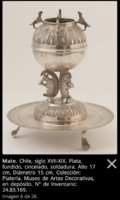Early Materials: Silver
Throughout the early history of Yerba Mate, the materials used for the utensils such as the bombilla or the mate were made from gourds, wood, and ceramics. However, the use of silver became introduced after the discovery of a silver mine in Potosí in 1545. Using silver as the material for the mate promoted dignity and distinction to the indigenous habit of the consumption of mate. Another benefit to the use of silver was that it was much more sanitary, since bacteria and fungi wouldn’t grow inside the mate as quickly.
Towards the south of Chile, there were two distinct fashion types of mate. One was simply the “southern mates” and the other were mates made from Coquimbo. The southern mates had a Mapuche influence, which was an indigenous tribe that lived in the South of Chile. In the image above, this mate has definitive Mapuche influences, highlighted by the ornate animals on the bottom of the mate and on the handles. You can also see the feet of the mate, which was bolted onto the bottom center of the mate. Coqiumbo made mates were more simple, and used lower grade silver with more engraved designs rather than animals.

